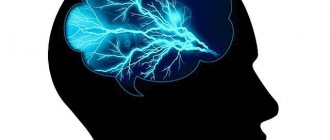The tasks of psychiatry include the study of the etiology and pathogenesis, causes and conditions of the occurrence of mental disorders and, in particular, schizophrenia. The ability to recognize schizophrenia at an early stage, before a detailed picture of the psychopathological state (psychosis), is necessary for the timely provision of psychiatric care, as well as measures to prevent the negative impact of the disease on the quality of life in general, on the formation of distorted adaptation mechanisms to life in the family and in society. Thus, progress in studying the question of whether schizophrenia is inherited helps to open up new opportunities for preventive treatment of the disease in the prodromal period, expanding its boundaries.
The clinical descriptive method today remains one of the leading methods for studying schizophrenia in fact. Its principles were outlined at the beginning of the last century by a domestic psychiatrist, a student of S.S. Korsakov and V.P. Serbsky, professor at Moscow University, A.B. Gannushkin. The principles of the method include identifying the characteristics of the patient’s personality, behavior in the environment and in relationships with other people, and compiling a life history. This approach is justified and is successfully used in the diagnostic and treatment practice of a psychiatrist. However, for obvious reasons, he does not pay sufficient attention to the factor of heredity in schizophrenia, which is important for identifying the prerequisites for the development of the disease in the period preceding the prodromal period.
In other words, in addition to the above principles of studying schizophrenia in fact, when a doctor deals with a specific patient with his own individual symptoms, interest in genetics and heredity is also important. The origins of the study of the genetic factor in domestic psychiatry were T.I. Yudin, founder of the genetics of mental illness, MD, professor, as well as D.S. Sarkisov, Doctor of Medical Sciences, Professor, Academician of the Russian Academy of Medical Sciences. The latter emphasized that changes at the molecular and subcellular level, as well as the influence of exogenous factors, indirectly affect regulatory mechanisms and the body as a whole. At the same time, the leading factor in the pathophysiology of schizophrenia, according to scientists, must still be considered disruption of the central nervous system, weakening of its epicritic function and the predominance of protopathic function.
Genetic factor and risk of developing schizophrenia
Since the beginning of the 21st century, geneticists have new, more accurate tools for diving into the human “code.” With their help, scientists test hypotheses about the likelihood of inheritance of schizophrenia. However, so far the gene or variation of genes responsible for heredity has not been discovered. To understand the scope of such research, you can familiarize yourself with the SZGene database, which contains more than 2,000 genes that can be tested for involvement in the inheritance of the disease. However, testing some of them in a genome-wide association study (GWAS) failed to establish a clear link between the candidate genes and schizophrenia.
In recent decades, there has been great interest in genetic research aimed at identifying the molecular causes responsible for the occurrence of schizophrenia. For example, among 6,429 scientific papers published on the website of The National Center for Biotechnology Information, 960 (15%) are devoted to the genetics of schizophrenia.
Genetic mutations in people with schizophrenia, compared to healthy people, are observed at the levels of:
- chromosomal mutations;
- point mutations in genes.
Chromosomal mutations in patients with schizophrenia include genomic aneuploidy and mosaic autosomal aneuploidy. These results obtained by domestic geneticists became the basis for the theory of chromosomal instability. Point mutations in genes are observed at the level of nucleotide replacement (single-nucleotide polymorphism) and copy number variations - replacement of pairs, genes, and their combinations. It is important to emphasize that genetic theories do not answer the question of whether schizophrenia is inherited, but only indicate the risk of the disease in carriers of chromosomal mutations and their children.
Genetic markers of schizophrenia are not absolute, since similar DNA changes are observed in genes responsible for various biological processes, for example: development of cells of the nervous system, neurotransmission, cellular respiration, transmission of nerve impulses. In addition, the putative genetic markers are found in only 1–5% of patients with schizophrenia.
Thus, genetic studies give reason to believe that heredity in schizophrenia is determined by deviations in the development of the body at various levels. A variety of variations in biopsychological abnormalities can cause the development of schizophrenia, but at the genetic level they are always heterogeneous and cannot be reduced to a single basis. Perhaps it is for this reason that various pictures of endogenous psychoses are encountered in clinical practice.
Rice. 1. Lifetime risk of developing schizophrenia
Who can get sick?
The disease can begin at any age, however, most often the onset of schizophrenia occurs at the age of 20–25 years.
According to statistics, the incidence is the same in men and women, but in males the disease develops much earlier and can begin in adolescence.
In females, the disease is more acute and is expressed by vivid, affective symptoms .
According to statistics, 2% of the world's population . There is currently no unified theory of the cause of the disease.
The likelihood of inheriting schizophrenia
To date, genetic research and clinical practice do not provide any basis for a positive answer to the question of whether schizophrenia is inherited. In most cases, schizophrenia is diagnosed in people who have healthy parents and do not have people with mental disorders in their family tree. In addition, Mendel's laws (in particular, the transfer of genetic information from parents to children) do not work in terms of predicting the inheritance of the disease, even in cases where both parents have schizophrenia.
The number of people with schizophrenia from the entire population does not exceed 1%. According to a large Swedish study published in 2013 in the journal JAMA Psychiatry, those who were able to start a family have children - 1/4 of families where the father has schizophrenia, 1/2 of families where the mother has schizophrenia. In particular, it is associated with low fertility in men with schizophrenia and frequent miscarriages or stillbirths in women with schizophrenia. The results of the study correlate with the data obtained by domestic scientists (R.A. Nadzharov, A.V. Snezhnevsky - the following are the figures of this study), published in 1983.
Possibility of transmitting schizophrenia from father
The probability of inheriting schizophrenia from father to child does not exceed 3.1%. If there are two children in such families, unfavorable heredity is more likely to affect male children. Girls, as a rule, may be predisposed to the disease if they have a brother in the family.
The risk of developing schizophrenia in a child in families where the father is ill:
- 2 sisters - tends to 0%;
- 2 brothers - no more than 6.4%;
- brother and sister - 1.8% for sister, 5.1% for brother.
Rice. 2. The likelihood of transmitting schizophrenia from the father
Possibility of maternal transmission of schizophrenia
The probability of inheriting schizophrenia from mother to child does not exceed 14.8%. If such a family has two children, then the risk of a hereditary factor increases if there are two female children. However, boys in such families still have a greater predisposition to the disease compared to families where the father has schizophrenia.
The risk of developing schizophrenia in a child in families where the mother is ill:
- 2 sisters - tends to 17.8%;
- 2 brothers - no more than 11.1%;
- brother and sister - 16.3% for sister, 7.4% for brother.
Rice. 3. The likelihood of transmission of schizophrenia from the mother
Chances of transmitting schizophrenia if both parents are sick
If both parents in a family have schizophrenia, the risk of inheriting the disease tends to be 15%. However, it is necessary to understand that these figures vary from study to study (the limit value is 45%) and in most cases the likelihood of transmitting the disease, even seemingly due to such aggravating heredity, is still doubtful.
What kind of disease is this?
Schizophrenia is a chronic progressive disease that includes a complex of psychoses that arise as a result of internal causes not related to somatic diseases (brain tumor, alcoholism, drug addiction, encephalitis, etc.).
As a result of the disease, a pathological change in personality occurs with a violation of mental processes, expressed by the following symptoms :
- Gradual loss of social contacts, leading to isolation of the patient.
- Emotional impoverishment.
- Thinking disorders: empty, fruitless verbosity, judgments devoid of common sense, symbolism.
- Internal contradictions. Mental processes occurring in the patient’s consciousness are divided into “his own” and external, that is, those that do not belong to him.
Associated symptoms include the appearance of delusional ideas, hallucinatory and illusory disorders, and depressive syndrome.
The course of schizophrenia is characterized by two phases: acute and chronic. In the chronic stage, patients become apathetic: mentally and physically devastated. The acute phase is characterized by a pronounced mental syndrome, which includes a complex of symptom-phenomena :
- the ability to hear one's own thoughts;
- voices commenting on the patient’s actions;
- perception of voices in the form of dialogue;
- own aspirations are realized under external influence;
- experiences of impact on your body;
- someone takes away his thoughts from the patient;
- others can read the patient's thoughts.
Schizophrenia is diagnosed if the patient has a combination of manic-depressive disorders, paranoid and hallucinatory symptoms.
Risk of schizophrenia in children of healthy parents
In recent decades, researchers in the field of genetics of mental disorders have come to the conclusion that the hereditary factor is not the leading one. Therefore, it is impossible to answer the question of whether schizophrenia is inherited using only a genetic factor, without taking into account many others that determine the results of related studies. In particular, the probability of developing schizophrenia in a child in families where both parents are not burdened with severe mental disorders is 5–7% (E. Zerbin-Rudin, 1967; V.M. Gindilis, 1979).
Due to the fact that healthy parents may give birth to a child with a predisposition to schizophrenia, there is interest in research emphasizing the relationship between the risk of developing a mental disorder and external, exogenous factors - family income level, social status, type of settlement and character of the area, accessibility medical care (in particular during childbirth) and education, social environment, level of cultural development.
Rice. 4. Biopsychosocial model of schizophrenia development
Developed and developing countries
Studies attempting to identify patterns in cases of schizophrenia in developed and developing countries have not yielded clear results, although there is a tendency for the number of hospitalizations to increase in developed countries. Locally, this % increases due to the migration factor - adaptation features, difficult living conditions and social isolation, including life on the “periphery” (Crocetti, 1971; Torrey, 1984; Nuallain, 1987).
Place of residence
Living in cities is associated with a high risk of TBI, intoxication, and adverse effects on the human body. Some cities are affected by hazardous enterprises and have high levels of gas pollution. Living in such an environment differs from life in the countryside - with clean air, water and farm-quality food, outside the acoustic “background” of the city (urban residents get used to it, stop noticing its negative impact), without stress, without artificial tension in the information field .
Pregnancy and childbirth
The connection between the risk of developing schizophrenia in the fetus and the seasonality of childbirth is also reflected in many scientific publications devoted to this topic. These studies highlight the fact that late winter and spring births predominate among patients with schizophrenia (Eaton, 1988). Among the hypotheses explaining the seasonal factor are the following:
- seasonal endocrine effect (Hafner, 1990);
- high percentage of older women giving birth (Dalen, 1990);
- the influence of environmental temperature on gestation and childbirth (Pasamanick, 1986; Kendell, Adams, 1991);
- previous FLU, other seasonal diseases (Watson, 1984; Torrey, 1988; Barr, 1990);
- the influence of medications taken during pregnancy (Beiser, Iacono, 1990).
Family income level
The socioeconomic factor that determines the risk of developing schizophrenia is associated with belonging to low-income, poorly educated and marginal groups (Faris and Dunham, 1939; Schroeder, 1942; Gardner and Babigian, 1966; Giggs and Cooper, 1987). In such families, children have to deal with “real life” much earlier than their peers, for example, endure psychological and often physical violence, observe pathological relationships between father and mother.
There are several theories explaining the pathological influence of the “social environment” and low income:
- theory of social drift - schizophrenia leads a person to socio-economic collapse;
- social stress theory - stress inherent in low-income people leads to the development of schizophrenia;
- neuroontogenetic theory - diseases and other harmful factors that accompany the life of immigrants and marginalized sections of the population create the preconditions for the development of schizophrenia.
Children born into such families usually do not have the opportunity to get an education, advance up the career ladder, or reach a higher socio-economic standard of living. However, the increasing level of unemployment and other socio-economic shocks can affect society as a whole, therefore, in times of crisis, an increase in the number of cases of schizophrenia is observed not only in low-income and vulnerable sections of the population.
Psychotraumatic events and stress
It is traumatic events that in most cases lead to the development of schizophrenia, and not the amount of stress that accumulates over a long period of time (Brown, Birley, 1986; Norman, Malla, 1993). One of the major WHO studies (Study on the determinants of outcome of severe mental disorder, 1987) emphasizes the dominant role of severe traumatic events 2–3 weeks before the development of signs of an acute psychotic state.
Immigration
Immigration is always a big stress. And if adults come to such a decision, as a rule, consciously, thinking through the move, then children find themselves truly unprotected in the face of unexpected changes in life. Unfortunately, the psychological preparation of children only partially smoothes out the immigration process, not allowing the child to fully ensure a comfortable transition. It should be noted here that a larger number of cases of schizophrenia is characteristic of the second generation of immigrants (Harrison, 1988).
Family (schizophrenogenic mother)
The concept of a family where parents create conditions under which a child develops schizophrenia is not new. The hypothesis was expressed by Freud and subsequently developed in the works of prominent psychiatrists, for example, the famous clinician F. Fromm-Reichmann (1948), B. Suran and D. Rizzo (1979). The key figure in such a family is the schizophrenogenic, or schizogenic, mother:
- despotic, domineering woman;
- shows hyperprotection over the child;
- does not allow the child’s personality to develop;
- rejects the child emotionally;
- provokes anxiety and fears in the child;
- does not allow the child to express “I”.
The father in such a family plays a secondary role; he is not involved in raising children and does not have the “right to vote.” A child in such a family finds himself in a situation where his personality has been suppressed since childhood. Against the background of pathological overprotection, the formation of natural adaptation mechanisms is disrupted, the development of the emotional-volitional sphere and, as a consequence, the personality with its inherent individual characteristics is blocked.
Ultimately, such a person turns out to be incapable of independent life in society and does not have healthy skills for creating and living in his own family. His “I,” suppressed over decades of life under the control of a schizophrenogenic mother, structures an irrational “adaptation” picture of the world (an analogue of the second “I”), including fears and, accordingly, prerequisites for the development of a psychotic state. As a rule, such people live under the care (for example, of parents or spouses, if they manage to start a family) and leaving the comfort zone, which involves a conflict between the pathological picture of the world and real life, can provoke the development of schizophrenia.
In 1992, the results of a prospective field study of five populations were obtained (AY Tien, WW Eaton), which refute the common belief that 1% of people with schizophrenia in the population. In other words, outside of clinical statistics, the percentage of patients with schizophrenia varies from 0.24 to 7.1% per 1000 people, depending on the region. This percentage includes people with a socially acceptable form of the disease, “adapted” to life in society, and who have not turned to a psychiatrist for help.
At what age can a child be diagnosed?
Schizophrenia in a child whose parents are sick can begin at any age.
Canadian psychiatrists admit the possibility of the onset of the disease in children under 3 years of age .
However, according to the results of many studies, the disease was diagnosed in children no earlier than 5 years of age.
Childhood schizophrenia is expressed by the following symptoms:
- fear;
- sadness;
- cognitive decline;
- speech disorder;
- sleep and appetite disorders;
- retardation in height and weight.
Children of primary school age experience disturbances in communication with peers, emotional impoverishment, a state of excitement, and lethargy of motives.
family aspects as a trigger in the development of the disease in children .
Special clinical and genetic studies of families of children with schizophrenia revealed that in 70% of cases the parents had schizoid symptoms.
A psychiatrist talks about the causes of schizophrenia in children:
List of used literature
1. Tiganov A.S. "Manual of Psychiatry in 2 volumes."
2. Tiganov A.S. "Endogenous mental illnesses."
3. Gannushkin P.B. "Selected Works".
4. Snezhnevsky A.V. "Schizophrenia, a multidisciplinary study."
5. Reznik A.M., Kostyuk G.P., Khannanova A.N. “Problems of the preconditions of schizophrenia according to molecular genetic studies.”
6. Kolesnichenko E.V., Barylnik Yu.B., Golimbet V.E. "The influence of the BDNF gene on the phenotypic expression of paranoid schizophrenia."
7. Cardno AG, Gottesman II “Twin studies of schizophrenia: from bowand-arrow concordances to star wars Mx and functional genomics.”
8. Need AC, Goldstein DB “Next generation disparities in human genomics: concerns and remedies.”
9. Sullivan PF, Kendler KS, Neale MC “Schizophrenia as a complex trait: evidence from a meta-analysis of twin studies.”
10. Power RA, Kyaga S., Uher R. “Fecundity of patients with schizophrenia, autism, bipolar disorder, depression, anorexia nervosa, or substance abuse vs their unaffected siblings.”
11. Nadzharov R.A., Snezhnevsky A.V. "The risk of manifestation and clinical features of schizophrenia depending on the gender of parents and children."
12. Warner R., Giovanni de Girolamo. "Schizophrenia".
Who is a schizophrenic
- The patient suffers from anxiety and depressive disorders.
- Adaptation disorders that develop as a result of the disease lead to the schizophrenic becoming a drug addict or alcoholic. Such people can be found among the homeless, the poor, and the unemployed.
- He suffers from chronic diseases and low immunity, so he lives less than healthy people by about ten years.
- A schizophrenic person usually has suicidal intentions, which increases the risk of suicide.
- It seems to the patient that some foreign forces are acting on him.
- A schizophrenic may believe that someone is controlling his thoughts, some of them are stealing, others are planting them.
- A schizophrenic hears his own thoughts in sound.
- Very often, a schizophrenic fears that his thoughts may become available to other people.
- The patient perceives voices that comment on his actions and thoughts, talking with each other.
Today, the reliability of the above symptoms as signs of schizophrenia has been questioned, but they are taken into account if other criteria used to define the disease coincide.
As a rule, to determine schizophrenia, doctors resort to analyzing the patient’s complaints and studying his behavior. When diagnosing schizophrenia, standard signs and symptoms, the severity of the illness, its duration, and information received from relatives and other mental health professionals are taken into account. The difficulty of making a diagnosis lies in the fact that symptoms characteristic of schizophrenia can be detected in other mental disorders. They accompany not only schizophrenia, but also occur in borderline states, biopolar or schizoaffective disorder, drug psychosis, and overdose of psychoactive drugs.
Cost of treatment in our clinic
| Service | Price | |
| Ambulatory treatment | ||
| Psychiatrist consultation | 4 500 ₽ | |
| Consultation with a psychotherapist | 4 500 ₽ | |
| Psychodiagnostics extended | 6 000 ₽ | |
| Consultation with a psychiatrist at home | 4 400 ₽ | |
| Treatment in hospital | ||
| Delivery to hospital | For free | |
| Standard room | 7 300 ₽ | |
| 3-bed superior room | 10 200 ₽ | |
| 2-bed superior room | 13 000 ₽ | |
| 1 local VIP chamber | 18 000 ₽ | |
| Doctor's appointment 2 weeks after discharge | For free | |
How to avoid being at risk
Knowing about the predisposition to mental disorders, it is quite possible to avoid the peculiar “activators” of schizophrenia.
To do this you need:
- Lead a healthy lifestyle.
- It is necessary to give up alcohol and any substances that can affect the psyche.
- It is also advisable to establish a diet and engage in physical activity.
- It is required to undergo regular examinations with a psychologist.
Self-medication is strictly prohibited. It is necessary to share experiences, this will help to avoid apathy and further development of pathology. Stressful situations or too high loads should not be allowed.
With the right approach, schizophrenia is quite treatable and the patient can live a fairly long life with a clear memory and mind.









